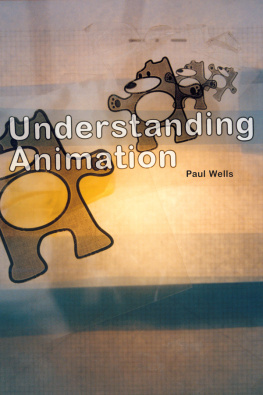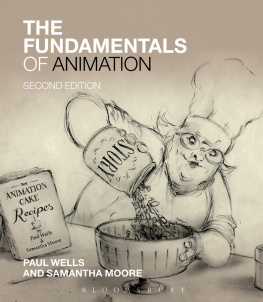Paul Wells - Understanding Animation
Here you can read online Paul Wells - Understanding Animation full text of the book (entire story) in english for free. Download pdf and epub, get meaning, cover and reviews about this ebook. year: 1998, publisher: Routledge, genre: Romance novel. Description of the work, (preface) as well as reviews are available. Best literature library LitArk.com created for fans of good reading and offers a wide selection of genres:
Romance novel
Science fiction
Adventure
Detective
Science
History
Home and family
Prose
Art
Politics
Computer
Non-fiction
Religion
Business
Children
Humor
Choose a favorite category and find really read worthwhile books. Enjoy immersion in the world of imagination, feel the emotions of the characters or learn something new for yourself, make an fascinating discovery.
- Book:Understanding Animation
- Author:
- Publisher:Routledge
- Genre:
- Year:1998
- Rating:3 / 5
- Favourites:Add to favourites
- Your mark:
- 60
- 1
- 2
- 3
- 4
- 5
Understanding Animation: summary, description and annotation
We offer to read an annotation, description, summary or preface (depends on what the author of the book "Understanding Animation" wrote himself). If you haven't found the necessary information about the book — write in the comments, we will try to find it.
Understanding Animation — read online for free the complete book (whole text) full work
Below is the text of the book, divided by pages. System saving the place of the last page read, allows you to conveniently read the book "Understanding Animation" online for free, without having to search again every time where you left off. Put a bookmark, and you can go to the page where you finished reading at any time.
Font size:
Interval:
Bookmark:
Understanding Animation is a comprehensive introduction to animated film, from cartoons to computer animation. Paul Wells insightful account of a critically neglected but increasingly popular medium explains the defining characteristics of animation as a cinematic form, outlines different models and methods which can be used to interpret and evaluate animated films, and traces the development of animated film around the world, from Betty Boop to Wallace and Gromit.
Part history, part theory, and part celebration, Understanding Animation includes notes towards a theory of animation; an explanation of its narrative strategies; an analysis of how comic events are constructed; a discussion of representation, focusing on gender and race, and primary research on animation and audiences. Throughout, Paul Wells argument is illustrated with case studies, including Daffy Duck in Chuck Jones Duck Amuck , Jan Svankmajers Jabberwocky, Tex Averys Little Rural Riding Hood and King Size Canary, and Nick Parks Creature Comforts. Understanding Animation demonstrates that the animated film has much to tell us about ourselves, the cultures we live in, and our view of art and society.
Paul Wells is Subject Leader in Media Studies at De Montfort University in Leicester.
First published 1998
by Routledge
2 Park Square, Milton Park, Abingdon, Oxon OX14 4RN
Simultaneously published in the USA and Canada
by Routledge
711 Third Avenue, New York, NY 10017
Routledge is an imprint of the Taylor & Francis Group, an informa business
1998 Paul Wells
Typeset in Joanna and Bembo by
J&L Composition Ltd, Filey, North Yorkshire
All rights reserved. No part of this book may be reprinted or reproduced or utilized in any form or by any electronic, mechanical, or other means, now known or hereafter invented, including photocopying and recording, or in any information storage or retrieval system, without permission in writing from the publishers.
British Library Cataloguing in Publication Data
A catalogue record for this book is available
from the British Library
Library of Congress Cataloguing in Publication Data
ISBN 978-0-415-11596-4 (cased)
ISBN 978-0-415-11597-1 (limp)
This is my first book-length discussion, and for some readers this will be self-evident, while others will feel that it offers some interesting topics for discussion and further research. Whatever the response, all of its flaws are mine; all of its enthusiasm for animation mine also.
Id like to thank a number of people for their help and encouragement. Firstly, I am grateful to the School Of Humanities at De Montfort University in Leicester for granting me study leave to complete the book, and to Tim OSullivan, Pat Kirkham, and the staff of the Media Studies subject team for their support. My special appreciation goes to Laraine Porter, my co-tutor on the Animation Studies course from which much of the work presented here was developed. Further, my thanks go to all the students who contributed so much to the courses development and success. For additional help, over and beyond the call of duty, as they say, my gratitude goes to Jayne Pilling, Terry Gilliam, Nick Park, Joanna Quinn, Mark Baker, Barry Purves, Bob Godfrey, Roger Noake, Andy Darley, and especially Marysia Lachowitz and Margaret OBrien at the British Film Institute/Museum of the Moving Image Education.
A final note of thanks goes to Rebecca Barden and all of the staff at Routledge for all their patience and hard work.
This book is dedicated with all my love to my wife, Joanne.
I am grateful to the following copyright holders for the provision of stills to be used as figures in this book:
Playful Pluto (1934) courtesy of Disney and the BFI
The Haunted Hotel (1907) courtesy of the BFI
Composition in Blue (1940) courtesy of the BFI
Lapis (1965) courtesy of the London Film Makers Co-operative and the BFI
The Street (1976) courtesy of the National Film Board of Canada and the BFI
Jumping (1984) courtesy of Tesuka Productions and the BFI
The Hand (1965) courtesy of the BFI
Tale of Tales (1979) courtesy of Soyuz Multfilm and the BFI
Feet of Song (1988) courtesy of Lee Stork and the BFI
Pas a Deux (1988) courtesy of the BFI
Special Delivery (1978) courtesy of the National Film Board of Canada and the BFI
Bobs Birthday (1995) courtesy of the National Film Board of Canada, Channel Four, Snowden Fine Productions and the BFI
Tin Toy (1988) courtesy of Pixars Animated Studios and the BFI
Asparagus (1979) courtesy of Suzan Pitt and the BFI
Girls Night Out (1986) courtesy of the BFI
Every effort has been made to trace copyright holders of the illustrations. In the event of any queries please contact Routledge, London.
He did several studies of the streetcar and when he held them together and flipped the pages it appeared as if the streetcar came down from the tracks from a distance and stopped so that the people could get on and off. His own delight matched the girls. She gazed at him with such serene approval that he had a fever to create for her. He bought some more scrap paper. He imagined her on ice skates. In two nights he made one hundred and twenty silhouettes on pages not bigger than his hand. He bound them with string. She held the little book and governed the pages with her thumb and watched herself skating away and skating back, gliding into a figure eight, returning, pirouetting, and making a lovely bow to her audience.
(Doctorow, 1976: 95)
Humankind has always been fascinated by moving images. The desire to make pictures move has provoked some of the most innovative developments in the fields of Science and Technology during the twentieth century. Curiously though, it is this very fact which has inhibited a proper recognition of the animated film and animation as an art form. The profound pleasure, recorded here by novelist, E.L. Doctorow, in the construction and use of an animated flip book, recognises the relationship between the artist and the actual creation of movement that so intrinsically informs the art of animation, an art that precedes its recording on film. Doctorow stresses the appeal of making images apparently move the fever to create which underpins the work of all animators.
Animation, in this sense the skill of animating images by hand, frame-by-frame became only one of the approaches by which pioneering film-makers tried to create and record moving images. The driving imperatives of the pioneers were largely technological in that they were testing the capability of a new medium in a mechanistic rather than aesthetic way The development of the camera was more important than the things it photographed (though these things became important both to film-makers and historians as the medium progressed). Consequently, the techniques of photography, and the skills of the photographer subsumed the art and craft of animation and surpassed the early , but particularly significant was the work of French professor, Emile Reynaud, who invented the Praxinoscope:
It consisted of a cylindrical box attached to a pivot. A coloured strip of paper on the inside face of the cylinder showed the consecutive stages of a movement. When the cylinder rotated, these stages were reflected in rapid succession on a mirrored prism mounted on the pivot, and the viewer who looked at the prism would see the drawn image move freely.
(Bendazzi, 1994: 4)
Font size:
Interval:
Bookmark:
Similar books «Understanding Animation»
Look at similar books to Understanding Animation. We have selected literature similar in name and meaning in the hope of providing readers with more options to find new, interesting, not yet read works.
Discussion, reviews of the book Understanding Animation and just readers' own opinions. Leave your comments, write what you think about the work, its meaning or the main characters. Specify what exactly you liked and what you didn't like, and why you think so.





